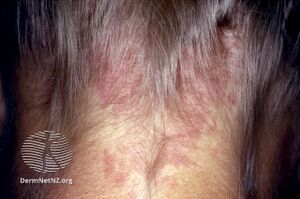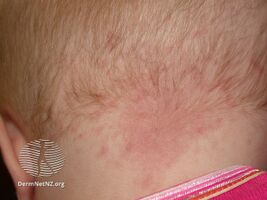Stork bite
| Stork bite | |
|---|---|
| Other names: Nevus flammeus simplex nuchae; nevus flammeus simplex of nape of neck; erythema nuchae; unna nevus | |
 | |
| Specialty | Dermatology |
| Differential diagnosis | Port-wine stain (naevus flammeus) |
Stork bite, also known as naevus flammeus simplex nuchae, is a birth mark that presents as a pink patch on the neck.[1] It is a type of naevus simplex that occurs on the neck.[1]
It is a type of capillary malformation.[1]
It occurs in about 25% of newborns.[2] Both sexes are affected with similar frequency.[1]
Signs and symptoms
These birthmarks, which are pinkish and irregularly shaped, occur most frequently on the back of the neck; however, they are also common on the forehead, eyelids and upper lip.[3] A baby may be born with it or it may appear in the first months of life. They may also be found occasionally on other parts of the body. The skin is not thickened and feels no different from anywhere else on the body; the only difference is in appearance. They may become darker when the child cries or strains.[4]
-
Salmon patch
-
Salmon patch
Pathophysiology
They result from a dilation of capillaries in the skin.[5]
Diagnosis
Diagnosis is by looking at the area. No tests are needed.
Treatment
No treatment is needed. If a stork bite lasts longer than 3 years, it may be removed using laser surgery.
Outlook
Most stork bites on the face go away completely in about 18 months. Stork bites on the back of the neck usually do not go away.[6]
Epidemiology
Stork bites occur in a significant number of newborns, with estimates ranging from 22–40 percent[3] to 40–70 percent.[5] They are reported more frequently for white babies than for infants of other races.[3]
Etymology
"Nevus flammeus nuchae" is Latin for "flame-like mole on the nape." Nevus flammeus in other contexts refers to a port-wine stain, which is a more permanent mark. The term "stork bite" refers to the folklore idea that storks bring newborn babies to parents.
See also
- Midline naevus flammeus, also known as an angel's kiss or a salmon patch.
- Mongolian spot
- Naevus flammeus, better known as a port-wine stain.
References
- ↑ 1.0 1.1 1.2 1.3 "Naevus simplex | DermNet". dermnetnz.org. Archived from the original on 9 June 2023. Retrieved 29 September 2023.
- ↑ "Nevus flammeus nuchae (Concept Id: C4024829) - MedGen - NCBI". www.ncbi.nlm.nih.gov. Archived from the original on 20 October 2023. Retrieved 29 September 2023.
- ↑ 3.0 3.1 3.2 Fletcher, Mary Ann (1998). Physical Diagnosis in Neonatals. Philadelphia, PA, US: Lippincott-Raven. p. 151. ISBN 978-0-397-51386-4. Archived from the original on 2023-10-20. Retrieved 2023-08-29.
- ↑ Zitelli, Basil John; McIntire, Sara C.; Nowalk, Andrew J. (2012). Zitelli and Davis' Atlas of Pediatric Physical Diagnosis (6 ed.). Philadelphia, PA, US: Elsevier Saunders. p. 351. ISBN 978-0-323-07932-7.
- ↑ 5.0 5.1 Habif, Thomas P. (2016). Clinical Dermatology. Amsterdam, Netherlands: Elsevier. p. 913. ISBN 978-0-323-26183-8. Archived from the original on 2023-10-20. Retrieved 2023-08-29.
- ↑ MedlinePlus Encyclopedia: Stork bite
External links
| Classification |
|---|

